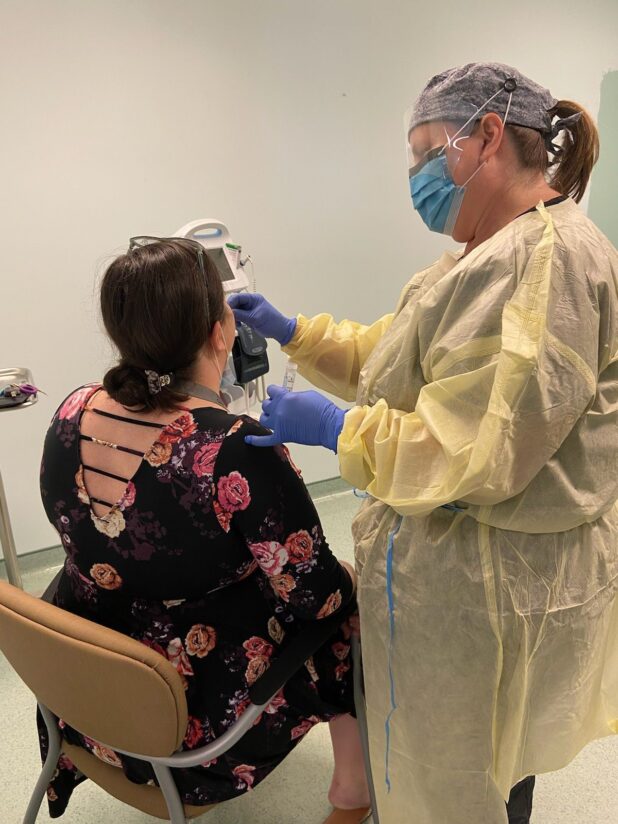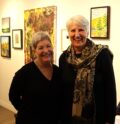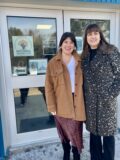Headline News
Medical officer of health gives update on state of the pandemic
November 17, 2020

Nov. 17, 2020
By Nate Smelle
Last week, Ontario’s science advisory table released its most recent projections detailing the state of the pandemic across the province. This new scientific modelling indicated that if no further action is taken to flatten the curve, by mid-December the province could see up to 6,500 new cases of COVID-19 each day. In light of this recent development, The Bancroft Times reached out to Hastings Prince Edward Public Health’s medical officer of health and CEO, Dr. Piotr Oglaza. The following is a collection of excerpts from the conversation between Dr. Oglaza and The Bancroft Times reporter, Nate Smelle.
Smelle: Thanks for taking the time to give us an update on the state of the pandemic, and public health’s response here in Hastings and Prince Edward counties. How are things going?
Dr. Oglaza: You’re welcome. We are going ahead with our plan with regard to response, with regard to case contact management, so this is something that is our routine work. It is busy, but we are on top of everything.
Smelle: Considering the recent projections by the province of a possible 6,500 cases a day in Onatrio, do you feel the restrictions and measures in place are sufficient as we head into the winter?
Dr. Oglaza: That’s a very good question, because any intervention comes with risks and benefits. Whether we are talking about a medication, or whether we are talking about a public health intervention, we always have to weigh the risks versus the benefits. Right now I can speak for Hastings and Prince Edward counties with the relatively low case counts, and in my opinion the restrictions that are in place for our area are serving their purpose. We need to remain vigilant, we need to remain mindful of what to do to prevent transmission but the restrictions as they are, are serving that goal.
For other parts of the province it depends on what the situation there is. If there is a particular type of setting that results in a significant outbreak, there might be a targeted intervention that is needed to prevent that spread. But, these interventions always have to be implemented with a thoughtful manner, so that the consequences and the costs of the intervention does not exceed the benefits. In terms of cost I am not just speaking with economical parameters, I am talking about the overall cost of an intervention such as the closing of schools. That’s something that could potentially have a profound impact on the children’s future. Their education is one of the significant social determinants of health that determines the health of the individual for years to come; and, that determines how there adult life will go.
This is something where we would have to have a very good reason to implement that type of intervention which impacts that important determinant of health. Again, it is something that needs to be looked at very thoughtfully – look at what the goals are of the intervention versus what benefits we get from it, what warms come with it, and how to balance these.
The measures that we currently have in place are resulting in the level of transmission that we have. If we let our guard down, if we become complacent and the transmission rate goes up, then we may need to have more stringent measures, and we want to avoid that. Everyone has to do their part in terms of preventing that transmission, so we can keep the schools open, we can keep society running the way we are right now with this level of restrictions; and in hope that they will eventually be lifted.
Smelle: Recognizing that the science pertaining to COVID-19 is always evolving, is there anything you have learned about COVID-19 recently that you would like to share with the public?
Dr. Oglaza: We know now that what we call the “three Cs”- close proximity, confined, crowded places – are the settings in which the virus spreads more easily. So, being outdoors, being physically distant, avoiding confined, crowded spaces is something that is going to keep us safe, and that’s a very important line of defence. What’s important is to make sure that all the other controls are in place, and that we don’t rely on just masks alone as one measure. So, if you are wearing a mask but still staying for an extended period of time in confined quarters with close proximity to others, that’s going to increase your risk.
As well it is very important for people more than ever to remember that if someone is not feeling well, or someone feels that they might have a cold coming up, this very well could be another respiratory virus, it may not necessarily be COVID-19, but at that point the individual should really consider getting tested for COVID-19; as well as stay away from others and isolate themself not to pass that virus, whether its COVID-19 or another respiratory virus, to others. That’s really the first line of defence – to remove or isolate those individuals who are sick from people who are not sick, and prevent transmission that way.
Smelle: So basically if you see any symptoms, even if you think it’s just a cold or allergies, it is best to go and get tested?
Dr. Oglaza: Absolutely because you cannot tell from just symptoms alone whether it’s a cold or if it is COVID-19. Initially when we were thinking of COVID-19 we were thinking of a triade of a fever, a cough, shortness of breath, but these are signs of severe illness. Especialy if someone is not part of a risk group they might just have very mild symptoms; and, these mild symptoms could. It could be a bit of a runny nose or a sore throat. Sometimes it could be as little as feeling a bit fatigued, or like you didn’t sleep well at night. So, very discrete symptoms that could be the start of severe illness. At that time, these mild symptoms should be causing enough alarm to get tested and make sure it is not COVID-19.
Smelle: By the questions I have been receiving from the public, there seems to be a bit of confusion regarding when people should get tested. Can you clarify when it is necessary to get tested?
Dr. Oglaza: Right now we still have capacity to do more testing. The testing is conducted by our partners under Ontario Health, and Quinte Health Care is leading that effort with Hastings Quinte Paramedic Services, so there are a lot of places where individuals can get tested. What is important, and I think that is part of the confusion, is that anyone with symptoms, or anyone directed by public health are individuals who should get tested.
We are moving away from the concept or message that even if you don’t have symptoms you should get tested. Testing without symptoms does not provide sufficient yield. It is not that valuable, unless again it is part of outbreak investigations of people who are known to be in close contact with the disease… But, if someone just feels like, well, I am just going to get tested even though I feel fine because I want to be sure, that’s not a good use of resources. So, only get tested if you were either instructed to do so by public health; or, if you have symptoms.
Smelle: I can see how the COVID-19 Alert app could help let people know if they need to be tested. Is there a link for people to access it on the HPE Public Health website?
Dr. Oglaza: Yes, it is listed under the resources, and we recommend the use of the app [www.covid-19.ontario.ca/covidalert]. It has limitations for certain types of professions. Let’s say you are a health-care worker and you wear personal protective equipment; and, as part of your employment you are interacting with people with COVID-19, perhaps an alert from the app does not mean that you have been exposed in a way that would warrant testing. But, for the general population it is a really good tool.
Smelle: Is there anything else people should know about the app?
Dr. Oglaza: I think it worth mentioning, because there has been a lot of misconception about the app, that this app is not intended to spy on you. This app does not collect any personal information. It just connects with other phones without identifying information. Basically, it shows you if you have been in proximity to someone with the virus. It does not keep track of whose phone it is.
Also, in order to make that app effective individuals have to put in the details of their test. Let’s say they got tested and tested positive, it is the individual who is the owner of that phone that has to enter that information on the app; which then allows the app to go back in time and compare the location of your phone against the location of other phones for a duration of time, and that’s how it gives notification to others.
Smelle: There seems to be several conspiracy theories online, for instance, the one claiming that the COVID-19 pandemic is a hoax; and another claiming the wearing of masks, practicing good hand hygiene, and physical distancing are an unnecessary attack on our freedom and our economy. What advice do you have for the people who are sharing or reading this misinformation?
Dr. Oglaza: I take the same approach as I do with people who are against vaccines, like this sort of anti-vaxxer movement. These are people who have really fixed beliefs that are not grounded in reality, and it might be very challenging to convince them otherwise, to look at the evidence. I think our focus should be on those who have high information needs, want to know and want to do what is best for themselves and their families; and, might be influenced by those spreading misinformation, or credible sources of information.
For all of those people who have questions and wonder who is right, and whether these extraordinary claims are true and correct, I would advise them to look at the credible sources of information. Look at our website at Hastings Prince Edward Public Health, look at the Public Health Agency of Canada, look at the Ontario Ministry of Health, look at Public Health Ontario and all the provincial resources. Look at the evidence and information on those sites, as opposed to a video on YouTube that someone might have filmed in their basement, where they present their opinions that are very well not grounded in reality, facts, and science.
Smelle: It is frustrating to see how many people buy into these myths. It’s dangerous as well.
Dr. Oglaza: Especially the belief that the pandemic is not real. It is real, we have people in this country, in this province who are hospitalized with COVID-19 … that’s not a hoax. There are truly sick people from this infection. What is true is that not everyone with COVID-19 will get severely sick. Someone might be pointing to somebody who has COVID-19 who is doing very well, has low-intensity symptoms, and they recover very quickly. That’s great and that’s good for them, but it is a reality that millions of people across the world are infected, a number of people are dying, and a number of people are severely affected by this virus.
The virus is real, it’s just what happens is that some individuals are more vulnerable than others. That’s the important message. We may not ourselves be in that vulnerable group, but it is our responsibility to prevent the spread and the transmission of the virus, so we are protecting those around us who are more susceptible to very COVID-19 related illness, very severe complications, or even death.
Smelle: What about the argument that COVID-19 is just another flu; and, that the reacton is overblown because people die from the flu every year?
Dr. Oglaza: This is something novel. This is something that we don’t know exactly what the full impact will be if this disease goes completely unchecked in the population. There are measures, there are precautions in place, and again there are a number of infectious diseases across the world that are claiming a significant toll year after year, but these are not new diseases. This is novel and we do not know the full impact. It is reasonable for us to maintain the proper level of precautions to prevent the spread, and protect the vulnerable around us.
To the point about the flu taking such a high toll every year, that’s another reason why we recommend flu immunizations. It’s not ideal, but it does provide some level of protection; and, we encourage everyone to get immunized. We know that despite all the messaging about immunizations and the flu, we still do not have a high enough proportion of the population immunized year after year. There is always going to be some level of resistance to measures that we propose.
Again, with COVID-19 we are seeing that it is leading to increased hospitalizations on a population level in the province. We’ve seen that increased occupancy in hospitals, that increased occupancy in ICUs, and we want to make sure that capacity is maintained. So, if we left that virus completely unchecked in the population, we could end up with overflowing hospitals, emergency departments, intensive care units; and at some pont we may run out of the resources that would otherwise help people and prevent them from dying while they are recovering from COVID-19. So, part of the response is to make sure that health-care system capacity is maintained.
Smelle: What can you tell us about the recent developments in the search for a vaccine?
Dr. Oglaza: The vaccine does bring hope that we will have a way of removing people from the group of susceptibles. That’s sort of an epidemiological term, but the idea is that if you have a vaccine you are no longer susceptible to the disease, so then you are safer, you are not going to get sick, you are not going to transmit. The vaccine is a tool in limiting the disease’s spread. It’s one of the tools, it’s not the only tool, it’s not something we can rely on solely.
We are always going to need some level of precautions, and if someone is sick I still recommend that they isolate themselves and not interact as if no one else around them is susceptible. We don’t know what the vaccine is going to be like when it is used in the real world. We know some of the promising initial reporting of the vaccine’s effectiveness, but again that is something that needs to be confirmed with studies and with research on the ground once the vaccine is being used. So it is something where I remain cautiously optimistic that it will be a good vaccine, but again it is not going to be the only tool at our disposal, and it has to be used in combination with all the other tools.
Smelle: OK I see. So it is not quite time to throw away our masks quite yet.
Dr. Oglaza: No, not yet. It is important to know that just because the FDA approves something [in the U.S.] it doesn’t mean that our Canadian bodies that are tasked with regulating vaccines, and approving them to bring them to the market are actually following the same process. Vaccines are one of the safest medical interventions there are, and that’s because there is such a formal process with getting them on the market.
We don’t want a vaccine that is not fully tested, fully tried, fully understood to be given to the population that is otherwise well, and using it as a preventative measure. That’s why our process takes time. It is intended to create vaccines in a way that we can say we are confident in their safety. That’s really important to understand. So, it still might be months before we have that data, and that reassurance that it is a safe vaccine to be brought to our population here in Canada. I am only speculating because I don’t have the insight to what the process is and where we are with that process in Canada, but it is more likely to be months than weeks.

















